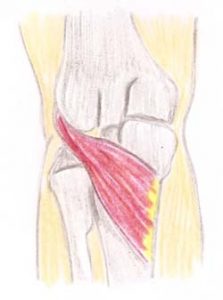
When your experiencing knee pain, it is very likely that this small muscle located at the back of your knee will be involved. It’s known as “the key which unlocks the knee” because of it’s role in ‘unlocking’ the joint from an extended position (bending your knee from a straightened position). Because of the tight space where it is located, the popliteus has a short belly of muscle with diagonal muscle fibres. It is the deepest muscle of the posterior knee and sits beneath the gastrocnemius and plantaris. This means that only the attachment at the tibia is accessible.
Where is it?
The Popliteus sits in the space behind your knee. It’s origin is the lateral condyle of the femur and it’s insertion is the proximal, posterior aspect of the tibia.
What does it do?
The popliteus medially rotates the flexed knee. It flexes the knee, but only weakly. The popliteal tendon starts and maintains internal rotation of the tibia, assisting the posterior cruciate ligament.
Popliteal Injuries
Injuries to the lateral cruciate ligament (LCL) of the knee can impact on the popliteus. The LCL acts to limit varus stress placed on the knee when the lower leg is turned inwards. This can result in a tendon injury in the popliteus from lateral knee instability.
Popliteal tendon over-use injuries are not very common but can occur with runners and downhill walking. Symptoms can include pain at the lateral femoral condyle (the outside and slightly above your knee) and when walking or running down a hill – or stairs.
Popliteal bursitis (also known as baker’s cyst) is another uncommon injury. It occurs when the popliteus bursa – located in the same capsule as the muscle – swells in capsule as a result of knee joint irritant. Leaking synovial fluid from the joint causes the bursa to become distended to give a sensation of pressure, especially when bending. Bending and straightening the knee becomes difficult. Recovery can take 4-8 weeks.
Exercises for knee health
Exercises for good knee health involve working the quadriceps/hamstrings and hip above the knee and the gastrocnemius/soleus and ankle below. Always seek medical advise if you have any conditions which might make these stretches difficult.
Straight leg raise
Being able to straighten your knee is important in recovery from injury. Sit on the floor with your legs out in front of you and your back straight. Tighten your quadriceps (quads) on one leg as much as possible to straighten your knee fully. Now rotate the leg 45 degrees towards the floor whilst keeping your quads tight and your knee straight. Now lift the rotated leg off the floor a short distance, pause then lower the leg to return to the start position. Repeat on the other leg.
Links:
